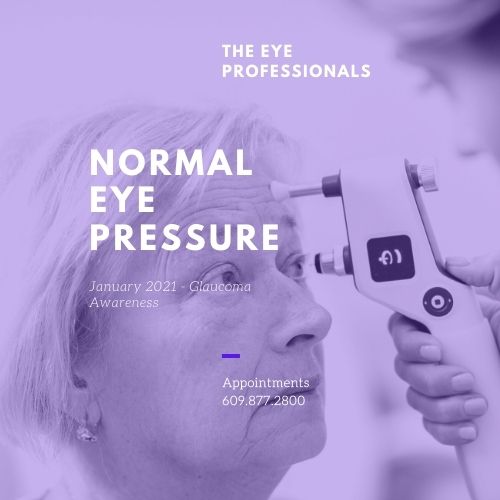What is Normal Eye Pressure?


January is National Glaucoma Awareness month. This article focuses on eye pressure (IOP) as a risk factor for developing or having glaucoma.
Eye pressure (also called intraocular pressure or IOP) is the measurement of the pressure caused by the fluid inside the eye. Like blood pressure, eye pressure is measured in millimeters of mercury (mm Hg).
The fluid creating the pressure inside the eye is aqueous humor and it is the flow of aqueous humor that keeps the eye properly inflated. Aqueous humor also delivers nutrients to the cornea and lens, both of which have no blood vessels to supply oxygen and nutrients.
In healthy eyes the production rate and drainage rate are equal. The amount of aqueous humor produced equals the amount flowing out. That keeps IOP in the normal range of 10 to 21 mmHg.
Pressure fluctuates slightly with body position and throughout the day but should be within that healthy range. Each person’s “normal” IOP is different, but generally a pressure higher than 21 mmHg is considered to be suspicious for glaucoma—high pressures that can damage your optic nerve.
As part of a complete eye exam, your ophthalmologist or an assistant will measure your eye pressure. The pressure check is called tonometry.
Checking Accurately
For many years IOP was checked with a puff of air that presses against and slightly flattens the cornea and then bounces back. That force of the “bounce back” gives the machine an eye pressure reading. That type of test is known as non-contact tonometry.
IOP Check with Contact Tonometry
A much more accurate way to measure intraocular pressure is with contact tonometry. It is done with a flat-tipped tonometer that gently touches the front of the cornea, slightly flattens it, and the force with which the eye pushes back is used to obtain an eye pressure reading. Patients usually remember seeing a blue light during this measurement.
Your eye will be numbed with numbing eye drops so you won’t feel the touch of the probe. The numbing eye drops also contain an orange dye that is used as a diagnostic tool.
After your eyes are numb, the front surface of your eye is touched with a tiny probe that glows with a blue light. The blue light is used so the orange dye in the numbing drops will glow green to identify any damaged areas of the cornea.
Why Pressure Checks are Important
The most common form of glaucoma doesn’t have any symptoms and it can destroy your optic nerve if left untreated. If you catch glaucoma in its early stage before there is any vision loss, there are treatments that can help you maintain a healthy eye pressure and preserve your vision.
